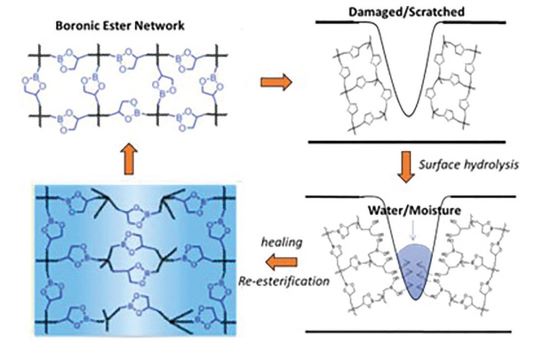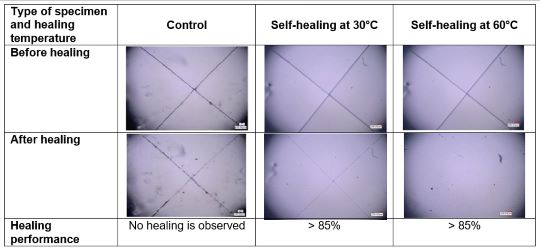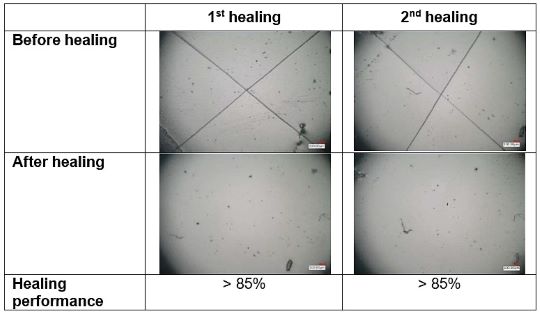The human body has a remarkable capacity for self-healing. The body can heal cuts and even promote bone growth in the event of a broken bone.
In a similar way, modern science is using smart coatings such as boronic ester (BE) networks that can self-heal when oil and gas pipelines start to break down.
In the oil and gas sector, assets are frequently exposed to extreme conditions, including high pressures, corrosive substances, and abrasive materials.
“Autonomous Healing of Smart Coating Materials for Corrosion Protection of Oil and Gas Assets,” a 2024 AMPP Conference paper, espouses the use of self-healing mechanisms to repair damaged pipelines.
“Self-healing as a smart material can be applied to the coating system to repair coating damage instantaneously,” the authors write. “Self-healing works in multiple functions where it can be used to protect against corrosion and at the same time heal the damaged area itself.”
The paper’s authors are Norfadilah Dolmat, Mohd Shamsul Farid Samsudin, and Azmi Mohammed Nor of PETRONAS, a global energy company that is Malaysia’s national oil and gas company, and Russell Varley and Jane Zhang, researchers at Australia’s Deakin University.

The Problem
In the oil and gas industry, metal parts like pipes are often damaged by corrosion due to tough environmental conditions. When these damaged areas are not quickly repaired, they can lead to serious failures and reduce the lifespan of materials. To prevent this, it’s important to quickly fix any scratches or cracks.
Corrosion is a major issue in the oil and gas sector, leading to higher maintenance costs and safety risks. Metal parts are particularly vulnerable due to constant exposure to harsh conditions. While coatings like paint can help protect against corrosion, they can be scratched, reducing their effectiveness. If not repaired, these scratches can worsen and lead to corrosion.
“Corrosion can weaken the structural integrity of assets, leading to dangerous situations and failure, which can disrupt production schedules and result in lost revenue,” Dolmat says.
Traditional protective coatings can wear down over time, leading to vulnerabilities that may result in costly repairs or replacements.
“Traditional protective coatings provide a barrier against environmental factors, but once damaged, they require manual intervention,” Dolmat says. “In contrast, self-healing coatings autonomously repair themselves, reducing the need for frequent maintenance and reapplication.”
Self-healing coatings offer a way to automatically repair scratches, improving their durability. There are two types of self-healing mechanisms: intrinsic (self-repairing by themselves) and extrinsic (requiring additional materials).
This research focuses on the intrinsic method, using BEs that can repair themselves when exposed to moisture. This could significantly enhance the long-term performance of coatings used in various applications, especially in challenging environments like oil and gas.
A promising solution is a type of coating that can “self-heal” when damaged. This smart material can not only protect against corrosion but also repair itself. The authors present a study that involves creating a new coating using BE and polyurethane (PUR), testing how well it heals itself, and assessing its performance against corrosion and other stressors.
The researchers chose BEs and PUR for coating applications because of a combination of their unique chemical properties, functional advantages, and the specific requirements of the intended application.
The reversible nature of the bonds formed by BEs can contribute to self-healing capabilities in coatings and adapt to environmental changes or stimuli, Dolmat explains. PUR coatings exhibit good resistance including UV, strong adhesion, and mechanical properties as a topcoat coating layer. The combination of BEs and PUR product can leverage the strengths of both materials.

Experiments and Results
To create the self-healing material, the researchers created BE and PUR and formed a mixture, then applied it as a topcoat onto a metal plate, creating a new type of coating designed to heal itself when damaged.
After the BE-PUR coating was applied, the researchers performed several tests to see how well it works.
Self-Healing Performance: They scratched the surface of the coating and placed it in a humidity chamber (80% relative humidity [RH]) at two different temperatures, 30 °C (86 °F) and 60 °C (140 °F), to observe if the coating would repair itself. After allowing time for healing, they measured how much the scratch depth had decreased using a 3D profilometer microscope to evaluate the healing performance.
Result: The researchers found that the self-healing coating repaired more than 85% of the scratches at both temperatures. The healed areas showed almost no visible scratch, confirming the coating’s ability to heal autonomously.
Electrochemical Impedance Spectroscopy: To assess the barrier properties of the self-healing coating, they conducted electrochemical impedance spectroscopy on both control and self-healing coatings after they were scratched. The specimens were placed in a humidity chamber at 60°C and 80% RH for 24 h to allow the self-healing process to occur.
Result: The self-healing coating, after healing, exhibited the highest impedance values compared to both unscratched and scratched control samples. This suggests that the coating significantly restored its barrier properties, providing improved resistance to moisture and corrosion.
Salt Spray Corrosion Resistance Test: The researchers tested the corrosion resistance of the self-healing and control coatings by exposing them to continuous salt spray for 3,000 h. The coatings were scratched with an X-cut pattern and then placed in the salt spray chamber at 35 °C, with the self-healing coatings undergoing a 24-h healing process before exposure.
Result: After 3,000 h, the control coatings showed severe rusting at the scratched areas. In contrast, the self-healing coatings showed no rusting, indicating that the healing process effectively restored the protective barrier and prevented corrosion. The self-healing coatings achieved a 97% healing performance after 24 h, with the scratch depth significantly reduced from 301 µm to 8 µm.
Cyclic UV/Salt Spray Test: To simulate real-world exposure conditions (sunlight and rain), the coatings were subjected to alternating UV and salt spray cycles for 4,200 h. The UV exposure was conducted for one week, followed by one week of salt spray exposure, to mimic the environmental conditions experienced in offshore oil and gas applications.
Result: The self-healing coating showed no signs of rust, blistering, or delamination after 4,200 h, demonstrating its outstanding durability under harsh conditions. On the other hand, the control coatings showed slight blistering, suggesting the self-healing coating’s superior long-term performance.
“The self-healing reaction has remained effective even after 4,200 h of cyclic UV/salt spray, indicating that the technology is highly reliable under conditions that would typically challenge conventional coatings,” Dolmat says.

Adhesion Test: To evaluate how well the self-healing coating adhered to the substrate, the researchers performed a pull-off adhesion test according to ASTM D4541. The self-healing coating was scratched, healed for 24 h at 60 °C and 80% RH, and then subjected to the adhesion test.
Result: The self-healing coating showed strong adhesion to the substrate, with adhesion strength values higher than the minimum requirement of 300 psi. The adhesion strength was comparable to that of the control sample, indicating that the self-healing coating remained stable and intact after healing.
Abrasion Test: The abrasion resistance of the self-healing coating was tested by subjecting it to 1,000 cycles of wear with a 1,000-gram load on an abrasion tester. The weight loss of the coating was measured before and after the test to evaluate its mechanical durability.
Result: The self-healing coating exhibited significantly lower weight loss compared to the control coating, demonstrating superior abrasion resistance. The weight loss was well below the PETRONAS internal standard of 150 mg per 1,000 cycles, confirming the self-healing coating’s excellent wear resistance.
Additional figures to illustrate these tests and results are available here.
Real-World Applications
The durability of self-healing coatings in real-world applications can vary significantly based on a multitude of factors, such as the specific type of coating being used, the environmental conditions to which the coating is exposed, and the inherent characteristics of the surfaces onto which the coatings are applied, Dolmat says.
Generally, self-healing coatings are designed to provide a lifespan that can range from several months to multiple years, depending on these influencing elements. In more stable environments, where conditions are less demanding, the longevity of these coatings may be notably extended.
Conversely, when self-healing coatings are subjected to severe conditions, their lifespan can be significantly compromised. To maximize the performance and durability of self-healing coatings, consistent maintenance and correct application methods are crucial.
“By adhering to best practices in application and maintenance,” Dolmat says, “users can ensure that self-healing coatings deliver their intended benefits, providing effective protection for an extended period.
The researchers will continue to rigorously examine and enhance the chemical formulation of these coatings, with the primary goal of maximizing their healing efficiency, longevity, and resistance to various environmental factors.
This involves not only refining the existing formulations but also exploring innovative materials and additives that can contribute to improved performance.
“To facilitate the successful commercialization of this technology, we intend to collaborate with industries that could benefit from the application of self-healing coatings such as paint manufacturers, asset owners, and additive manufacturers,” Dolmat says.
“This collaborative approach will enable us to tailor our formulations and application methods to specific use cases, ensuring that our self-healing coatings provide maximum value and effectiveness in real-world applications,” he adds.
Editor’s note: This article first appeared in the January 2025 print issue of Materials Performance (MP) Magazine. Reprinted with permission.